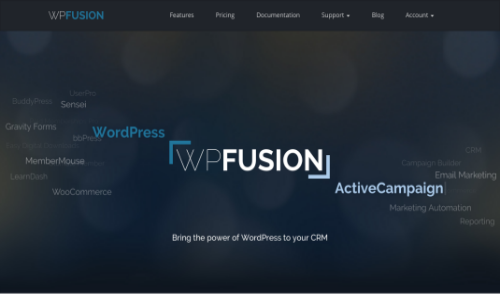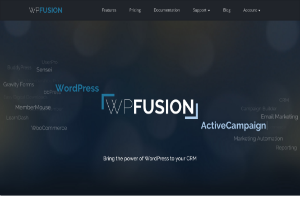
Are you looking for another way to add membership functionality and elevate your customers’ experience by leveraging site visitor and CRM data?
If so, let me introduce you to why the WP Fusion plugin just might be your next best tool.
WP Fusion enables your WordPress website to “talk” to your CRM application (and vice versa), using a lean open source code that doesn’t overly burden any API limitations you might have with your CRM provider.
Previous versions of the plugin integrated only with Infusionsoft, however, the latest version enables you to connect to many well-known CRMs you might be using, including ActiveCampaign, Zoho, Drop, and OntraPort.
How exactly does the WP Fusion builder work?
While your CRM provides you with click engagement from links contained within your emails, WP Fusion provides you with engagement from clicking at the website level. So, you can initiate automated triggers to apply and remove CRM tags and start/stop email campaigns based on specific user activity at the website level.
In action, the on-going data you collect allows you to put the right offer in front of the right audience and eliminates that all too familiar “spitball” sales and marketing approach we all-too-often lean towards when trying to build our businesses.
What specific data can you collect and monitor with WP Fusion?
You can use WP Fusion to track WHO is viewing what content, WHO is watching your videos, WHO is abandoning your e-commerce pages, WHO is clicking on your seasonal and promotional offers, and so on. Note: Some of these features require WP Fusion Plus & Professional service levels.
Additionally, you can easily identify those who are showing readiness to buy and further identify click patterns and overall interest in blog categories to benefit and expand your on-going content development campaigns.
To learn more about some of the top benefits of WP Fusion, continue reading.
Top 3 Benefits of WP Fusion:
1. You can lock and unlock content in your WordPress site based on CRM tags.
Yup!
Do you want the functionality of a membership site, without having to install a stand-alone membership plugin?
WP Fusion builder gives you the ability to control what content is seen by your customers based on specific tags in your CRM.
For example, let’s say you have a downloadable product link on a WordPress page that you only want specific customers to have access to. Using WP Fusion’s content protection feature, found in the right column when editing your page, allows you to specify what tag your customer must have to access the product link.
This also works for prospects when you want to control access to a specific lead magnet or special offer.
2. Affordably priced, investment for the plugin starts @ $247 for 1 year and 1 site.
Two additional service packages are available for $347 and $540 to cover add-on features (e.g. tracking video consumption and shopping cart abandonment).
There are no monthly fees, though there is something you should consider.
This is NOT a “one fee and done” plugin, and therefore expect to continue renewing your license yearly to receive new plugin updates and keep technical support.
This isn’t terrible.
In fact, for serious online businesses, using paid plugins that are continuously supported and updated helps your website stay secure. Security issues are a growing concern for online businesses — and therefore, using free WordPress plugins that are no longer updated (or properly maintained) will be security issues for those who use them.
3. Track prospects and customers based on clicks and behaviors performed on your website.
By far the most important feature that WP Fusion offers!
So, let’s review a few additional ways click and behavior tracking with WP Fusion might come in handy.
First, remember I said above, you can track HOW OFTEN logged-in site visitors click and WHAT topics they click.
Having this data would go a long way to helping you refine your marketing messages and therefore increase engagement.
So, let’s put this into context.
Let’s say you send a potential customer to your website to view several different service options. This was two days ago and you haven’t received a purchase or heard from the prospect.
Wouldn’t it be great to know which particular package your prospect viewed?
Maybe your prospect clicked on your shopping cart, started filling out the fields and then unexpectedly left your site.
Wouldn’t it be great to know this so you can have a member of your sales staff do a follow-up call?
Wouldn’t it also be great to know your prospect was interested in a 2-payment service option before your sales rep picks up the phone?
Remember what I said above? The right message in front of the right people.
Second, you can track how long someone spends watching your videos (Note: this is available only to those at the Plus & Professional package levels).
Why track video engagement?
Simply put individuals who spend more time viewing your content generally implies they are more interested in what you have to say and quite possibly could translate to a warmer prospect primed for a new purchase or a customer primed for another purchase.
Also, tracking video consumption helps those who are using learning management systems, such as LearnDash, “drip that next piece of content” to visitors once a previous piece of media has been consumed.
For example, let’s say you have a 5-part video training series on how small businesses can use YouTube to create a new revenue stream, and you want customers to watch your series in sequential order so they get the most value out of your training program.
So, you don’t release the 2nd video until your customer has consumed at least 1/2 of the first video. Then, you don’t release the 3rd video until at least 1/2 of the 2nd video has been consumed.
Makes sense, right?
Are you concerned WP Fusion will jump your API usage with your CRM?
CRMs like Infusionsoft have started putting restrictions on API usage as a way of controlling the use of resources.
If you’re concerned API usage between your CRM and WP Fusion will push your usage “over the edge,” here’s what you need to know:
All data is stored locally, unless you opt to resync the client record, therefore you shouldn’t experience any API throttling. You might, however, want to do a resync on the page right after they login to ensure your CRM has the most recent data — and after that everything is cached. This has become common practice amongst other membership plugins as well, such as Memberium.

